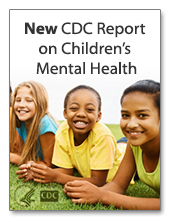 According to new Centers for Disease Control and Prevention (CDC) data, as many as one-fifth of the nation’s children may have a mental disorder, and per CDC researchers, the prevalence of children with such conditions appears to be increasing.
According to new Centers for Disease Control and Prevention (CDC) data, as many as one-fifth of the nation’s children may have a mental disorder, and per CDC researchers, the prevalence of children with such conditions appears to be increasing.
The report, Mental Health Surveillance Among Children — United States, 2005-2011, finds that since 1994, the rate of mental disorders among the nation’s young people has fluctuated from 13 percent to 20 percent of the total youth population in the United States.
The latest estimates indicate that attention-deficit/hyperactive disorder (ADHD) is the most common mental health disorder experienced by U.S. children, impacting about 7 percent of the nation’s 3-to-17 population. Approximately 3.5 percent of the nation’s young people demonstrated behavioral or conduct problems, researchers stated, while 3 percent and 2 percent, respectively, are estimated to experience anxiety or depression.
Approximately one out of every 100 children in the nation, CDC researchers state, are projected to have an autism spectrum disorder (ASD). Citing data from the National Health Interview Survey (NHIS), researchers detected a 3 percent increase in ADHD diagnoses among young people from 1997 to 2006, while a fourfold increase in autism diagnoses occurred between 1999 and 2008. From 2003 to 2007, data collected from the National Survey of Children’s Health (NSCH) indicated a nearly 22 percent increase in ADHD diagnoses among U.S. children.
Among young people ages 12-to-17, researchers estimated that nearly 5 percent of the population has used illicit drugs, with 4.2 percent experiencing an alcohol abuse disorder while a little under 3 percent were predicted to experience cigarette dependency.
In 2010, researchers noted that the suicide rate for young people was about 4.5 per 100,000 per young person ages 10-to-19. That year, suicide was the second leading cause of death among the nation’s 12-to-17-year olds.
According to the new figures, an estimated one-out-of 12 adolescents, ages 12-to-17, reported at least 14 “mentally unhealthy days” over the course of a one-month window. In all, the CDC predicts the annual public health costs of young people with mental health disorders to total, on average, $247 billion.
Researchers stated that prevalence rates fluctuated along racial and socioeconomic lines. While Hispanic children were found to have lower rates of ADHD compared to other populations, white children were found to be more likely than either blacks or Hispanics to receive diagnoses of ASDs, anxiety disorders, Tourette syndrome or alcohol use disorders. African-American children, on average, were found to have higher rates of behavioral or conduct problems than other demographics.
Regionally, substance abuse disorders were higher in Western states, while children in Southern states were likelier to be diagnosed with ADHD.
“Although numerous systems provide estimates of the prevalence of individual mental disorders in children, additional information is needed regarding the overall prevalence and impact of mental health issues on children,” the report concluded.
“Changes in estimated prevalence over time might be associated with an actual change in prevalence, changes in case definition, changes in the public perception of mental disorders, or improvements in diagnosis, which might be associated with changes in policies and access to health care.”
Photo Courtesy of CDC






























